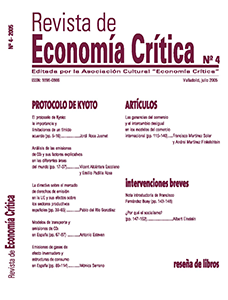Análisis de las emisiones de CO2 y sus factores explicativos en las diferentes áreas del mundo.
Keywords:
differences among regions, evolution of emissions, Kaya identity, Kyoto protocolAbstract
This article analyses the evolution of CO2 emissions –the major greenhouse gas- in the different regions of the world, paying special attention to what has happened in the European Union and Spain. The analysis focuses especially in what has happened since 1990, base year for the Kyoto Protocol for most countries. The article also studies the main driving forces of the emissions and of their evolution by means of the analysis of the Kaya factors identity. The analysis explains the great differences between regions and the different changes over time.
Downloads
References
ANG, B.W. (1999A): "Is the energy intensity a less useful indicator than the carbon factor in the study of climate change?", Energy Policy, Vol. 27, pp. 943-946. https://doi.org/10.1016/S0301-4215(99)00084-1
ANG, B.W. (1999B): "Decomposition methodology in energy demand and environmental analysis", en Berg, J.C.J.M. van den Handbook of Environmental and Resource Economics. Edward Elgar, Cheltenham, pp. 1149-1163. https://doi.org/10.4337/9781843768586.00091
ANG, B.W. Y LEE, S.Y. (1996): "Decomposition of industrial energy consumption: the energy coefficient approach", Energy Economics, Vol. 16, pp. 129-143. https://doi.org/10.1016/0140-9883(95)00049-6
BRUYN, S. M. DE Y OPSCHOOR, J. B. (1997): "Developments in the throughput-income relationship: theoretical and empirical observations", Ecological Economics, Vol. 20, pp. 255-268. https://doi.org/10.1016/S0921-8009(96)00086-9
ESTEBAN MARQUILLAS, J.M. (1972): "A reinterpretation of shift-share analysis", Regional and Urban Economics, Vol. 2, pp. 249-255. https://doi.org/10.1016/0034-3331(72)90033-4
EUROPEAN ENVIRONMENTAL AGENCY (EEA) (2004): Greenhouse Gas Emission Trends and Projections in Europe 2004. Progress by the EU and Member States towards achieving their Kyoto Protocol Targets, EEA, Copenhague. Disponible en: http://reports.eea.eu.int/eea_report_2004_5/en/GHG_emissions_and_trends_2004.pdf
INTERNATIONAL ENERGY AGENCY (IEA) (2003): CO2 Emissions from Fuel Combustion, OCDE, París.
KAYA, Y. (1989): "Impact of Carbon Dioxide Emission Control on GNP Growth: Interpretation of Proposed Scenarios", paper presented to the Energy and Industry Subgroup, Response Strategies Working Group, Intergovernmental Panel on Climate Change, París, Francia.
MIELNIK, O. Y GOLDEMBERG, J. (1999): "The evolution of the "carbonization index" in developing countries", Energy Policy, Vol. 27, pp. 307-308. https://doi.org/10.1016/S0301-4215(99)00018-X
OECD (2001): OECD Environmental Outlook, OECD, Paris, disponible en: http://www.oecd.org/dataoecd/51/6/2088589.pdf
PADILLA, E. Y ROCA, J. (2003): "Las propuestas para un impuesto europeo sobre el CO2 y sus potenciales implicaciones distributivas entre países", Revista de Economía Crítica, n. 2, diciembre, pp. 5-24.
ROCA, J. Y ALCÁNTARA, V. (2002): "Economic growth, Energy Use, and CO2 emissions", en Blachwood, J.R. (Ed.) Energy Research at the Cutting Edge. Nova Science Publishers, Nueva York, pp. 123-134.
ROCA, J. Y PADILLA, E, (2004): "Emisiones atmosféricas y crecimiento económico en España: la curva de Kuznets ambiental y el Protocolo de Kyoto", Economía Industrial, n. 351, (número monográfico: Ecología Industrial y Desarrollo Sostenible: Perspectivas nacional, regional y urbana), pp. 73-86.
SUN, J.W. (1998): "Changes in energy consumption and energy intensity: a complete decomposition model", Energy Economics, Vol. 20 (1), pp. 85-100. https://doi.org/10.1016/S0140-9883(97)00012-1
YAMAJI, K., R. MATSUHASHI, NAGATA, Y. Y KAYA, Y. (1991): An Integrated Systems for CO2/Energy/GNP Analysis: Case Studies on Economic Measures for CO2 Reduction in Japan. Workshop on CO2 Reduction and Removal: Measures for the Next Century, 19-21 March 1991. International Institute for Applied Systems Analysis, Laxenburg, Austria. https://doi.org/10.1016/0301-4215(93)90134-2
Downloads
Published
How to Cite
Issue
Section
License
This licence allows third parties to share (copy and redistribute the material in any medium or format) and adapt (remix, transform and create from the material for any purpose, including commercial purposes), provided that authorship and first publication in this journal (The Journal, DOI of the work) is acknowledged, a link to the licence is provided, and it is stated whether changes have been made to the work.







